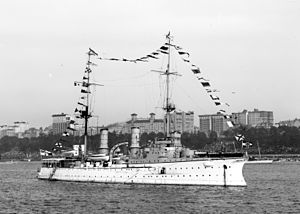Victoria Louise class protected cruiser
 SMS Victoria Louise in 1909
| |
| Class overview | |
|---|---|
| Name: | Victoria Louise |
| Operators: |
|
| Preceded by: | Kaiserin Augusta |
| Succeeded by: | Fürst Bismarck |
| Built: | 1895–1899 |
| In service: | 1898–1921 |
| Completed: | 5 |
| Retired: | 5 |
| General characteristics | |
| Class and type: | Victoria Louise class protected cruiser |
| Displacement: | Full load: 6,491–6,705 t (6,388–6,599 long tons) |
| Length: | 110.50–110.60 m (362 ft 6 in–362 ft 10 in) |
| Beam: | 17.40–17.60 m (57 ft 1 in–57 ft 9 in) |
| Draft: | 6.58–7.08 m (21 ft 7 in–23 ft 3 in) |
| Propulsion: |
|
| Speed: | 18.5 to 19.5 knots (34 to 36 km/h; 21 to 22 mph) |
| Range: | 3,412 nmi (6,319 km; 3,926 mi) at 12 knots (22 km/h; 14 mph) |
| Complement: |
|
| Armament: |
|
The Victoria Louise class of protected cruisers was the last class of ships of that type built for the German Imperial Navy. The class design introduced the combined clipper and ram bow and the blocky sides that typified later German armoured cruisers. The class comprised five vessels, Victoria Louise, the lead ship, Hertha, Freya, Vineta, and Hansa. The ships were laid down in 1895–1896, and were launched in 1897–1898 and commissioned into the fleet over the following year.
The first three ships were 110.60 meters (362 ft 10 in) long and displaced 6,491 metric tons (6,388 long tons) at combat load; Vineta and Hansa were a slightly modified design. They were 110.50 m (362 ft 6 in) long and displaced 6,705 t (6,599 long tons) at full load. All five ships were armed with a main battery of two 21-centimeter (8.3 in) guns and eight 15 cm (5.9 in) guns. The first three ships had a top speed of 19.5 knots (36.1 km/h; 22.4 mph); the last two were slightly slower, at 18.5 knots (34.3 km/h; 21.3 mph). Problems with the Niclausse boilers installed on Freya prompted the Navy to standardize boiler types in future warships.
The ships of the class served in various units in the German fleet, including on the America Station, in the East Asia Squadron, and with the home fleet. Hertha and Hansa participated in the suppression of the Boxer Rebellion in China in 1900, and Vineta was involved in the Venezuela Crisis of 1902–1903. All five ships were modernized between 1905 and 1911, after which they served as training ships for naval cadets. They were mobilized into the 5th Scouting Group at the outbreak of World War I in August 1914, but were quickly withdrawn from front-line service. They served in various secondary roles for the rest of the war. After the end of the conflict, Victoria Louise was converted into a merchant ship, but was broken up in 1923. The other four ships were scrapped in 1920–1921.
...
Wikipedia
